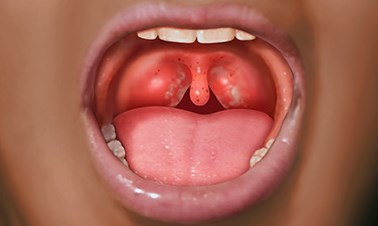 Tonsil stones are small lumps of hard material that form in the tonsils. Tonsil stones can cause bad breath though they are usually not painful or harmful. They are also called tonsilliths.
Tonsil stones are small lumps of hard material that form in the tonsils. Tonsil stones can cause bad breath though they are usually not painful or harmful. They are also called tonsilliths.
You can usually treat tonsil stones at home. But in some cases, you may need surgery to remove the tonsils.
What are tonsils?
The tonsils are a pair of small, oval-shaped bits of tissue at the back of your throat. They have folds, gaps and crevices called tonsillar crypts.
Tonsils are part of your immune system, which helps protect against infection. Tonsils filter bacteria and viruses that enter your body through your mouth. Removing the tonsils does not affect your immune system.
What do tonsil stones look like?
Tonsil stones look like little white or yellow pebbles on your tonsils. You may have one tonsil stone or many tonsil stones. They are usually small, though sometimes people can get large tonsil stones.
What is the difference between tonsil stones and tonsillitis?
Tonsillitis is a tonsil infection. Both conditions can cause bad breath and throat pain. Usually, if you have tonsillitis, you will also get red, inflamed tonsils along with a sore throat, fever and headache.
Who is at risk of tonsil stones?
People who have more tonsillar crypts tend to get more tonsil stones. These are also more commonly found in people who have had a lot of tonsil infections in their life. Tonsilliths tend to happen more often in teens.
How common are tonsil stones?
Tonsil stones are common. Many people get them and may not even know they have them.
What causes tonsil stones?
Materials and debris can get trapped in the tonsillar crypts. The material can harden or calcify, forming stones. Trapped material could include:
Minerals such as calcium.
- Food or debris.
- Bacteria or fungi.
- What are the symptoms of tonsil stones?
Some tonsil stones do not cause any symptoms. If you do have symptoms, they may include:
- Bad breath (halitosis).
- Cough.
- Earache.
- Sore throat.
- Bad taste in your mouth.
- Small white or yellow stones that you may spit up.
Other symptoms include:
- Difficulty swallowing.
- Feeling that something is stuck in your throat.
- Small white patches on your tonsils.
- Throat infections that are hard to treat with antibiotics.
How are tonsil stones treated?
Usually, treatment aims to manage tonsil stone symptoms. There is not a specific treatment method for stones. Make sure to:
You can try these at-home methods to get rid of tonsil stones:
- Gargling: Vigorous gargling using salt water has a few advantages. It helps your throat feel better, plus it can dislodge the tonsil stones. It may even get rid of the bad odor. This is particularly helpful when you gargle after eating to prevent food and debris from getting caught in the tonsil crypts.
- Coughing: Some people find that a strong cough can loosen stones and bring them up.
- Using an object: If gargling and coughing do not dislodge the stones, it is tempting to use your finger or a toothbrush to get rid of tonsil stones. But you can easily scratch your delicate tonsils. They can get infected. Instead, if you want to use an object, try a cotton swab.